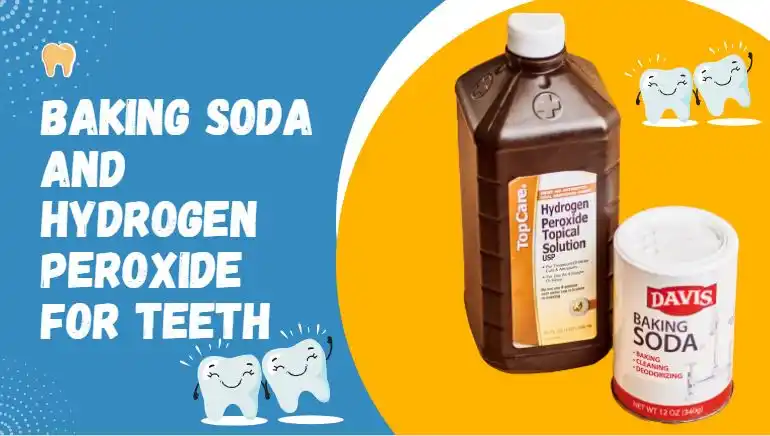I have always been interested in keeping my smile healthy and bright. Over the years, I have tried many teeth-whitening products like toothpaste, strips, and professional treatments.
I have experimented with different methods to make my smile brighter.
I found that a combination of baking soda and hydrogen peroxide is the best and most affordable way to whiten teeth.
Baking soda and hydrogen peroxide have been used for a long time to naturally whiten teeth, and scientific research supports their effectiveness.
Baking soda is a gentle scrub that can remove surface stains on teeth.
Hydrogen peroxide is a bleach that can go deeper into the enamel to break down and remove stains.
Understanding Teeth Discoloration
I know what it’s like to have discolored teeth and how frustrating it can be.
Teeth can become discolored for different reasons, so it’s important to know why and what types of discoloration there are in order to find solutions that work.
Causes of Teeth Discoloration
Teeth can become stained for a few reasons. One common cause is food and drinks like coffee, tea, red wine, and dark fruits and vegetables.
Smoking and tobacco use can also make teeth yellow and discolored. Poor oral hygiene is another cause.
Not brushing and flossing regularly lets plaque and tartar build-up on teeth, making them look yellow or brown. Certain medications, like antibiotics and antihistamines, can also discolor teeth.
Types of Teeth Discoloration
There are two main types of teeth staining: extrinsic and intrinsic. Extrinsic stains happen on the outside of the teeth and are usually caused by things like food, drinks, or smoking.
Intrinsic stains, on the other hand, happen inside the teeth and can be caused by different things like injuries, medication, or genetics.
It’s important to know which type of staining you have to find the best treatment.
For extrinsic stains, teeth-whitening treatments like baking soda and hydrogen peroxide can work well to remove surface stains.
But for intrinsic stains, more intense treatments like veneers or bonding might be needed.
Baking Soda and Hydrogen Peroxide
I have tried many ways to whiten my teeth, and I can say that using baking soda and hydrogen peroxide is a cheap and effective method.
I will explain how it works, the advantages, and the dangers.
How it Works
Baking soda, or sodium bicarbonate, is a gentle scrub that can remove stains on teeth.
When mixed with hydrogen peroxide, it reacts to break down discoloration on the tooth surface. Hydrogen peroxide is a bleach used in teeth-whitening products.
It can go through the enamel and break down stains, making teeth look whiter. When combined with baking soda, it makes a strong whitening solution.
Benefits
- Cost-effective: Baking soda and hydrogen peroxide are relatively inexpensive compared to other teeth whitening methods.
- Easy to use: You can easily find baking soda and hydrogen peroxide at any drugstore, and the application process is straightforward.
- Effective: Studies have shown that using a baking soda and hydrogen peroxide mixture can significantly whiten teeth.
Risks
While baking soda and hydrogen peroxide are generally safe to use, there are some risks to keep in mind:
- Overuse can damage tooth enamel: Using baking soda and hydrogen peroxide too often or leaving it on your teeth for too long can erode the enamel, making your teeth more vulnerable to decay and sensitivity.
- Gum irritation: The mixture can irritate your gums if it comes into contact with them. Be sure to apply it only to your teeth and rinse thoroughly afterward.
- Not suitable for everyone: People with sensitive teeth or gum disease should avoid using baking soda and hydrogen peroxide as it can aggravate their condition.
Methods of Using Baking Soda and Hydrogen Peroxide
Baking Soda and Hydrogen Peroxide Paste
To whiten teeth using baking soda and hydrogen peroxide, make a paste by mixing a bit of baking soda with hydrogen peroxide until it becomes thick and smooth.
Apply the paste to your teeth using a toothbrush, brushing in small circles for two minutes. Rinse your mouth well with water after brushing.
Remember, only use this method once or twice a week to avoid harming your tooth enamel.
Baking Soda and Hydrogen Peroxide Mouthwash
You can make a mouthwash for teeth whitening by mixing baking soda and hydrogen peroxide in equal amounts.
Swish the mixture in your mouth for 30 seconds to a minute, then rinse with water. You can use this method every day, but be aware that it might make your teeth sensitive.
If you feel sensitivity, use it less often or stop using it.
Precautions and Tips
Before using baking soda and hydrogen peroxide for teeth whitening, there are a few precautions and tips that you should keep in mind:
- Do not use this method too frequently as it can damage your tooth enamel and cause sensitivity.
- Use only a small amount of baking soda and hydrogen peroxide mixture, as too much can cause irritation and inflammation of the gums.
- Make sure to rinse your mouth thoroughly with water after using this method to remove any residue.
- If you experience any discomfort or pain, stop using this method and consult your dentist.
- It is important to note that baking soda and hydrogen peroxide should not be used as a replacement for regular dental cleanings and checkups.
Conclusion
I researched the pros and cons of using baking soda and hydrogen peroxide to whiten teeth. Both have natural whitening abilities that can remove stains on teeth.
However, it’s important to use them in moderation and not rely solely on them for whitening.
Using baking soda as toothpaste or mixing it with hydrogen peroxide can help reduce cavity-causing bacteria in the mouth.
However, be careful with baking soda as it can damage tooth enamel if used too often or in high concentrations.
Before trying any at-home teeth whitening methods, including baking soda and hydrogen peroxide, consult with a dentist for personalized advice based on your oral health.
Frequently Asked Questions
What are the side effects of using baking soda and hydrogen peroxide for teeth?
Using baking soda and hydrogen peroxide for teeth can cause side effects. The most common side effect is tooth sensitivity because baking soda is abrasive.
Also, the combination of baking soda and hydrogen peroxide can erode enamel over time, leading to discolored and weakened teeth.
Using this mixture too often can also increase plaque buildup on the teeth, as it does not effectively remove plaque like regular toothpaste.
What are the best ways to use baking soda and hydrogen peroxide for teeth?
You can use baking soda and hydrogen peroxide together to make a natural teeth-whitening solution.
Just mix equal amounts of baking soda and hydrogen peroxide in a bowl.
Dip your toothbrush in the mixture and brush your teeth for two minutes. Then rinse with water. You can use this mixture once or twice a week as part of your regular oral care routine.
What are the benefits of using baking soda and hydrogen peroxide for teeth?
Baking soda and hydrogen peroxide can naturally whiten teeth by removing surface stains and making them look brighter.
Baking soda scrubs away stains, and hydrogen peroxide breaks down discoloration. Using them together can bring back a bright white smile.
Can I use baking soda and hydrogen peroxide for teeth?
You can use baking soda and hydrogen peroxide to whiten teeth and reduce plaque. Baking soda is a natural remedy that polishes teeth and removes discoloration.

A Blogger, Author and Researcher! Gohar Aalam is recognized as a full-time blogger for Health and Tech Niches. I’m a Fountainhead of Gethealthup.com, will provides high quality knowledge.









1 thought on “Baking Soda and Hydrogen Peroxide For Teeth: Effective Teeth Whitening Solution”